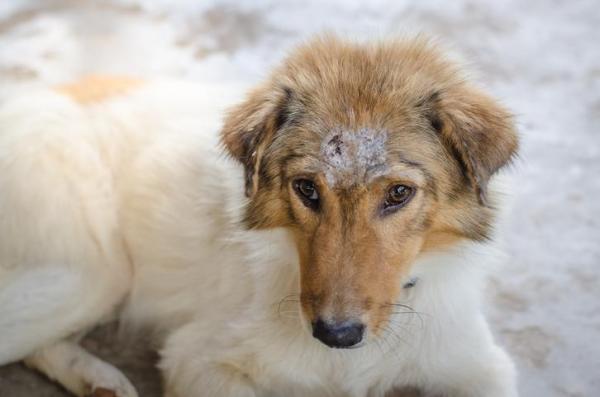Squamous Cell Carcinoma in Dogs



See files for Dogs
Knowing the different skin disease which affect dogs is an essential part of their care. Identifying changes to the condition of their skin can mean early signs of serious conditions are treated promptly. Observation of the dog's guardian is crucial as this is the way we can bring an issue to the attention of a veterinarian. Squamous cell carcinoma (SCC) is a malignant neoplasm of epithelial cells. The type of squamous cell carcinoma depends on its location, since squamous cells are found in the epithelium of various parts of the body. These include the skin, mouth, lining of respiratory tract, etc.
One of the most common types of squamous cell carcinoma is skin cancer. This type of skin cancer is relatively common in cats. In fact, it represents the most common cutaneous neoplasm in felines (15%). In canines, it is estimated that it occupies only the 8th place for cutaneous and subcutaneous neoplasms at around 4.6%. Still, it is very important we are made aware of them so that we can spot them promptly. In this AnimalWised article, we provide a general outline of squamous cell carcinoma in dogs, including their types, causes, related symptoms and treatment options.
What is squamous cell carcinoma in dogs?
As stated above, a squamous cell carcinoma is a neoplasm which affects epithelial cells. While epithelial cells are what make up the skin, they can also be found in other parts of the body, such as the mouth, thyroid or even genitals. A neoplasm is a type of abnormal tissue growth, something commonly found in tumors or cancers.
SCCs in dogs, as with humans, are associated with exposure to sunlight. They usually have a good prognosis, but this will depend on the health of the individual dog, how far the carcinoma has progressed and how early treatment is initiated.
While some neoplasms or tumors can be benign, a squamous cell carcinoma is malignant and potentially life threatening. When we see the presence of any initial symptoms, it is imperative we take the dog to a veterinarian for confirmation of diagnosis and so treatment can begin.

Symptoms of squamous cell carcinoma in dogs
Many of the changes to a dog's skin we can see are characteristic of malign neoplasms. For this reason, even if we think presence of a squamous cell carcinoma is unlikely, we need to seek advice from a specialist.
The most frequent symptoms of squamous cell carcinoma in dogs include:
- Ulcers
- Bleeding wounds
- Pustules
- Swelling (particularly of the mouth)
- Tooth loss
- Limping
- Lameness
- Crusty sores
- Excessive drooling
- Coughing
- Reddened areas
Keep in mind that skin lesions are classified as both primary and secondary. Secondary skin lesions are those which either derive from a primary lesion or are caused by the dog's behavior. For example, when a dog gets in a fight with another dog, they may have cuts or sores which resemble primary legions from skin cancer. This is another reason we need veterinary intervention to achieve a proper diagnosis.
Since sunlight is a factor in SCCs, there are certain parts of the body which are more likely affected. These are most often the parts covered in less hair, including the nose, anus, toes, eyelids, etc. For the same reason, hairless dog breeds are also more susceptible.
Types of squamous cell carcinoma in dogs
Neoplasms are generally classified according to the affected cells, although there are also classifications which are conditioned by the stage of the disease. For squamous cell carcinomas in humans, the TNM Classification of Malignan Tumors system is used. This uses the size of the tumor, nearby affected lymph nodes and metastasis to classify the cancer. The same system is not usually applied to animals, but the veterinarian may use it as a guide to identify how far the neoplasm has spread. Most often, this type of neoplasm does not spread. However, some cases of metastasis in dogs have been reported.
Another way to classify the type of squamous cell carcinoma is to do so by location. We have already stated that it generally affects areas most exposed to sunlight, but they can occur on almost any part of the dog's body. It is also important to remember that certain internal organs, such as the bladder, also contain squamous cells, so it is not only a type of skin cancer.
Diagnosis of squamous cell carcinoma in dogs
While we may have our own suspicions, definitive diagnosis of SCC will need to be carried out by a veterinarian. They will perform a physical examination before carrying out further diagnostic tests. The most characteristic of these tests is a biopsy whereby a portion of the tissue is removed and examined under laboratory conditions.
However, before a biopsy is undertaken, the veterinarian may try to distinguish between a squamous cell carcinoma and other skin conditions. They can do these by carrying out blood tests, skin scrapings and/or cytologies.

Treatment of squamous cell carcinoma in dogs
The treatment for this condition is not the same for all dogs. Neoplasms are very delicate pathologies and the treatment should be adjusted to each patient according to their individual clinical picture. Certain complications include the physical condition of the animal, whether or not the animal has a pre-existing condition or even the age of the dog. They need to be considered to best avoid iatrogenic illness, i.e. that which is caused by medical intervention.
The different treatments for squamous cell carcinoma in dogs are the following:
- Immunomodulators: they are a very common and efficient option for this type of pathology, usually yielding a good prognosis. They work by modulating the immune system and strengthening the body's resources.
- Chemotherapy: this type of treatment acts by directly destroying cancer cells. However, chemotherapy has many complications and side effects, so its use is very discretionary.
- Radiation therapy: the use of radiation therapy is often required in pathologies of this type. However, they are rarely used in dogs.
- Surgery: surgical intervention will depend on the phase and location of the lesion growth. It will be up to the veterinarian whether they can remove the tumor or reduce it with treatment.
The prognosis of squamous cell carcinoma in dogs is generally positive and does not usually merit invasive treatments. However, this does not rule out the few cases of metastasis, as it is still a type of malignant neoplasm.
This article is purely informative. AnimalWised does not have the authority to prescribe any veterinary treatment or create a diagnosis. We invite you to take your pet to the veterinarian if they are suffering from any condition or pain.
If you want to read similar articles to Squamous Cell Carcinoma in Dogs, we recommend you visit our Skin problems category.
- Buriticá, E., et al. (2007). Squamous cell carcinoma in a canine patient.
- Karen Moriello. (2011). Small Animal Dermatology. Manson Publishing.







